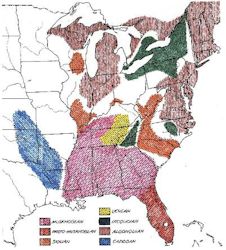The Woccon, Sissipahaw, Cape Fear, and Warren-Nuncock Indians
Of the North Carolina tribes bearing the foregoing names almost nothing is known, and of the last two even the proper names have not been recorded. The Woccon were Siouan; the Saxapahaw and Cape Fear Indians presumably were Siouan, as indicated from their associations and alliances with known Siouan tribes, while the Warren-nuncock were probably some people better known under another name, though they cannot be identified. The region between the Yadkin and the Neuse, extending down to the coast, was probably occupied by still other tribes whose very names are forgotten. They were virtually exterminated by smallpox and other … Read more

